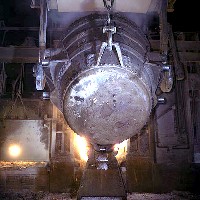Stuart Licht, a professor of chemistry at George Washington University (GWU) in Washington, D.C., has developed a carbon dioxide-free method of producing iron that uses solar energy and a process of solar conversion. Licht has patented this process, called Solar Thermal Electrochemical Photo (STEP) energy conversion, which offers an alternative to the same basic polluting methods of iron smelting used for more than three thousand years.
Licht’s methods extract pure metal iron from two prevalent iron ores, hematite and magnetite, without emitting carbon dioxide. His research over a span of 20 years has shown that iron ore at high temperatures is significantly more soluble than previously thought. In his most recent research, Licht uses electrolysis –- an electrical rather than chemical process to create a reaction –- to covert iron ore to iron metal. This high temperature electrolysis requires little energy, and can be powered through conventional or renewable energy sources to reduce or completely eliminate CO2 emissions.
With STEP, the electrolysis process is carbon dioxide free, creating no global warming gas emissions when converting the ore into metal. By using both solar thermal energy and visible sunlight, Licht says the STEP process converts more solar energy than the best solar cells, as it uses excess solar heat (energy discarded by solar cells) to produce iron. Licht and GWU colleague Baohui Wang published their findings in the current online issue of Chemical Communications.


 RSS - Posts
RSS - Posts
You must be logged in to post a comment.